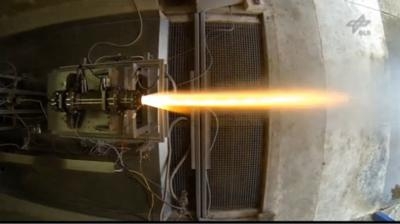Fri, Jan 31, 2014
DLR Engineers Research Tomorrow's Hybrid Engines
The concrete tube stretching across the German Aerospace Center (Deutsches Zentrum für Luft- und Raumfahrt; DLR) site in Trauen might be less than 11 feet wide, but every now and then it becomes outer space for around 10 seconds. This is the case when engineers at the DLR Institute of Aerodynamics and Flow Technology put their newly developed hybrid rocket engine through its paces.

Researchers take seats behind the 8-inch-thick, reinforced concrete walls in the control room while, in the test stand, liquid hydrogen peroxide reacts with solid fuel in a combustion chamber producing 530 pounds of thrust in the rocket engine. The first analyses of the Advanced Hybrid Rocket Engine Simulation (AHRES) project show that it might take just five to 10 years to develop an airworthy hybrid engine to launch a rocket into space.
By combining a solid propellant and liquid oxidizer in one engine, the DLR researchers hope to benefit from the advantages of both systems: "They are easier to build and handle than liquid propellant engines, which makes them less costly, and the fuels are not toxic," says DLR engineer Daniel Lancelle, listing the advantages. "You can control the thrust and ignite or switch off the engine as needed. The risk of explosion is also reduced in comparison with other engines." But the scientists are aware of the drawbacks of a hybrid engine – a lower combustion rate and reduced thrust. "At the moment we are working on understanding this new kind of engine and on improving the combustion rate and engine efficiency," explains researcher Ognjan BoA3/4iA. "And so far the results are promising."
A team comprised of DLR staff and students took it upon themselves to give the test stand at the DLR site in Trauen – unused for some 30 years – a makeover, installing state-of-the-art technology. Their purpose was to demonstrate that the hybrid rocket engine they had designed could work at least as efficiently as standard solid propellant engines. "You will not find another facility like this one in Europe," emphasizes Ognjan BoA3/4iA. The remote location of Trauen complies with all the safety standards required to plan future tests on larger engines with a thrust of up to 15 tons. Here, the engineers conduct tests with various solid fuels, modify the mixtures and analyze the course of combustion. The test results are then used to optimize the computer simulations.
This type of hybrid rocket engine could, for example, be used as the upper stage of a small to medium-sized launcher. "They can be deployed in research rockets and research aircraft operating at an altitude ranging from 40 to 180 kilometers – and therefore bridge the gap between airplanes and satellites," says project manager BoA3/4iA. They could also be used for spacecraft landings on the Moon and Mars. Their high degree of safety due to the separation of the different fuels before ignition opens up yet another field of application: space tourism.
"Our objective is to use the results obtained to develop engineering software that could be used by industry or research institutions to design this kind of engine or improve an existing design in just a few weeks," says DLR engineer Dennis Porrmann. Ognjan BoA3/4iA, Daniel Lancelle and Dennis Porrmann plan to conduct at least five more trials by mid-2015.
(Image provide by DLR)
More News
Runway Lead-in Light System Runway Lead-in Light System Consists of one or more series of flashing lights installed at or near ground level that provides positive visual guidance a>[...]
Aero Linx: Aviation Without Borders Aviation Without Borders uses its aviation expertise, contacts and partnerships to enable support for children and their families – at hom>[...]
Dave Juwel's Aviation Marketing Stories ITBOA BNITBOB ... what does that mean? It's not gibberish, it's a lengthy acronym for "In The Business Of Aviation ... But Not In The Busine>[...]
From 2010 (YouTube Version): Yeah.... This IS A Really Cool Job When ANN's Nathan Cremisino took over the lead of our Aero-TV teams, he knew he was in for some extra work and a lot>[...]
Also: Junkers A50 Heritage, Montaer Grows, Dynon-Advance Flight Systems, Vans' Latest Officially, the Carbon Cub UL and Rotax 916 iS is now in its 'market survey development phase'>[...]
 ANN's Daily Aero-Term (04.24.24): Runway Lead-in Light System
ANN's Daily Aero-Term (04.24.24): Runway Lead-in Light System ANN's Daily Aero-Linx (04.24.24)
ANN's Daily Aero-Linx (04.24.24) Aero-FAQ: Dave Juwel's Aviation Marketing Stories -- ITBOA BNITBOB
Aero-FAQ: Dave Juwel's Aviation Marketing Stories -- ITBOA BNITBOB Classic Aero-TV: Best Seat in The House -- 'Inside' The AeroShell Aerobatic Team
Classic Aero-TV: Best Seat in The House -- 'Inside' The AeroShell Aerobatic Team Airborne Affordable Flyers 04.18.24: CarbonCub UL, Fisher, Affordable Flyer Expo
Airborne Affordable Flyers 04.18.24: CarbonCub UL, Fisher, Affordable Flyer Expo



